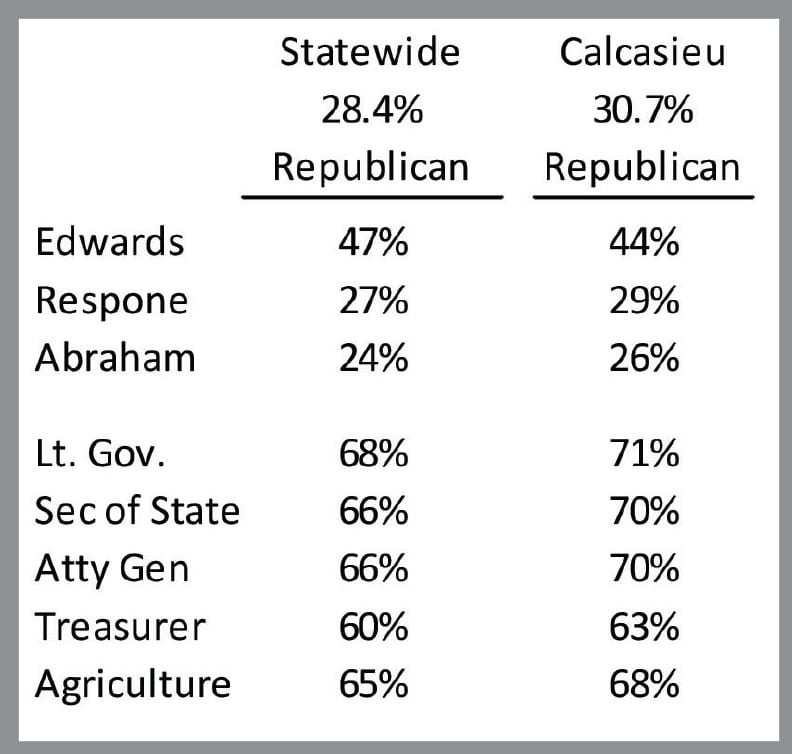On Oct. 12, Louisianans went to the polls and cast their ballots for candidates for state and local offices. It was the first stage in Louisiana’s electoral process, in which candidates who receive more than 50 percent of the vote are elected to office, but in races where no one receives a majority of the votes, there is a runoff election on Nov. 16 between the top two vote-getters.
T
President Trump stopped off in Lake Charles on Oct. 11 to implore Republicans to go to the polls and force Edwards into a runoff, although he did not endorse either Abraham or Rispone, saying only that they were both great candidates. He got his wish on Saturday, when Edwards received 47 percent of the vote to Rispone’s 27 percent and Abraham’s 25 percent. Thus, Gov. Edwards will face Rispone in the runoff election in November.

Four years ago, Edward’s three Republican challengers spent so much time trashing each other that the voters decided none of them were worthy of being governor and it tore the party apart.
This time around, the Louisiana GOP warned the candidates not to go negative on each other. But in the closing weeks of the campaign, Rispone, who was trailing Abraham in the polls, launched a series of attack ads against Abraham. It was nothing like four years ago. But it caused some pretty hard feelings among Abraham’s supporters as Rispone moved into the lead. Of course, Abraham graciously endorsed Rispone. But will his supporters forgive and forget and go enthusiastically to the polls for Rispone? We’ll see.
Another challenge Rispone faces is that Gov. Edwards is popular with many Republican voters as he is both pro-life and pro-gun, which takes away two of their most emotional issues. The small table at left shows the vote for governor compared to the vote for other state offices.
Statewide, the Republican candidates for the other offices received 66 percent of the vote; in Calcasieu Parish it was closer to 70 percent. But for governor, the combined Republican vote was only 51 percent.
This indicates there was a lot of ticket-splitting going on, with 15 percent of those who voted a straight Republican ticket crossing over to vote for Edwards. Thus, Rispone has not only to win back Abraham’s supporters, but he must also win over these ticket-splitters.
I have a hunch, and it is only a hunch, that we are about to see a torrent of negative ads against Edwards aimed at eroding this support. (I don’t like them, but apparently they work, which is why politicians use them.)
Rispone and Abraham spent a lot of time arguing back and forth about who was the bigger Trump supporter (which is understandable because the president is very popular in Louisiana). But this is a state election, not a national election, and Louisiana is facing many problems.
What I’ve heard many people say is they knew Abraham and Rispone both love Trump, but had no idea about how they planned to deal with the state’s problems. In the runoff election, Rispone needs to focus on articulating how he plans to deal with state issues and not just criticize the job Edwards has done with the mess he inherited.
The election also displayed a longterm trend in Louisiana politics: in 2000, just 22 percent of Louisiana voters were registered as Republicans, and they were outnumbered 5-to-2 by Democrats. There were only a few enclaves where a Republican stood a chance of getting elected (in Calcasieu Parish, they were Moss Bluff and south Lake Charles).
However, over the last 20 years, as the Democrat Party drifted further to the left, nearly half (46 percent) of the white voters registered as Democrats abandoned it. Some became independents (up 56.6 percent) while others switched to the Republican Party (up 37.9 percent).
The voters who were registered Republicans in 2000 tended to be ideological conservatives (otherwise why register in a party that has little chance of winning?).
Many of the “new” Republicans and independents, however, are populists driven more by issues than ideology. They are much more prone to split their ticket and feel little remorse about voting for someone on the ballot who has a “D” after their name.
The Republican Party in Louisiana has grown, but registered Republicans are still only 30 percent of the total registered voters, and they need significant support from independents to win elections.
Louisiana is often called a red state because it has tended to vote Republican in presidential elections. I’ve called it a “blue state with red frosting” because those presidential votes don’t translate down to the local level where Republicans were — and still are —outnumbered by registered Democrats. But the results of the Oct. 12 election in Calcasieu Parish indicate that is changing.
A Democrat candidate has a decent chance of winning only in districts with a significant black population, with the one notable exception being Sheriff Tony Mancuso’s, who received 88 percent of the vote and was elected to his fifth term.














Comments are closed.